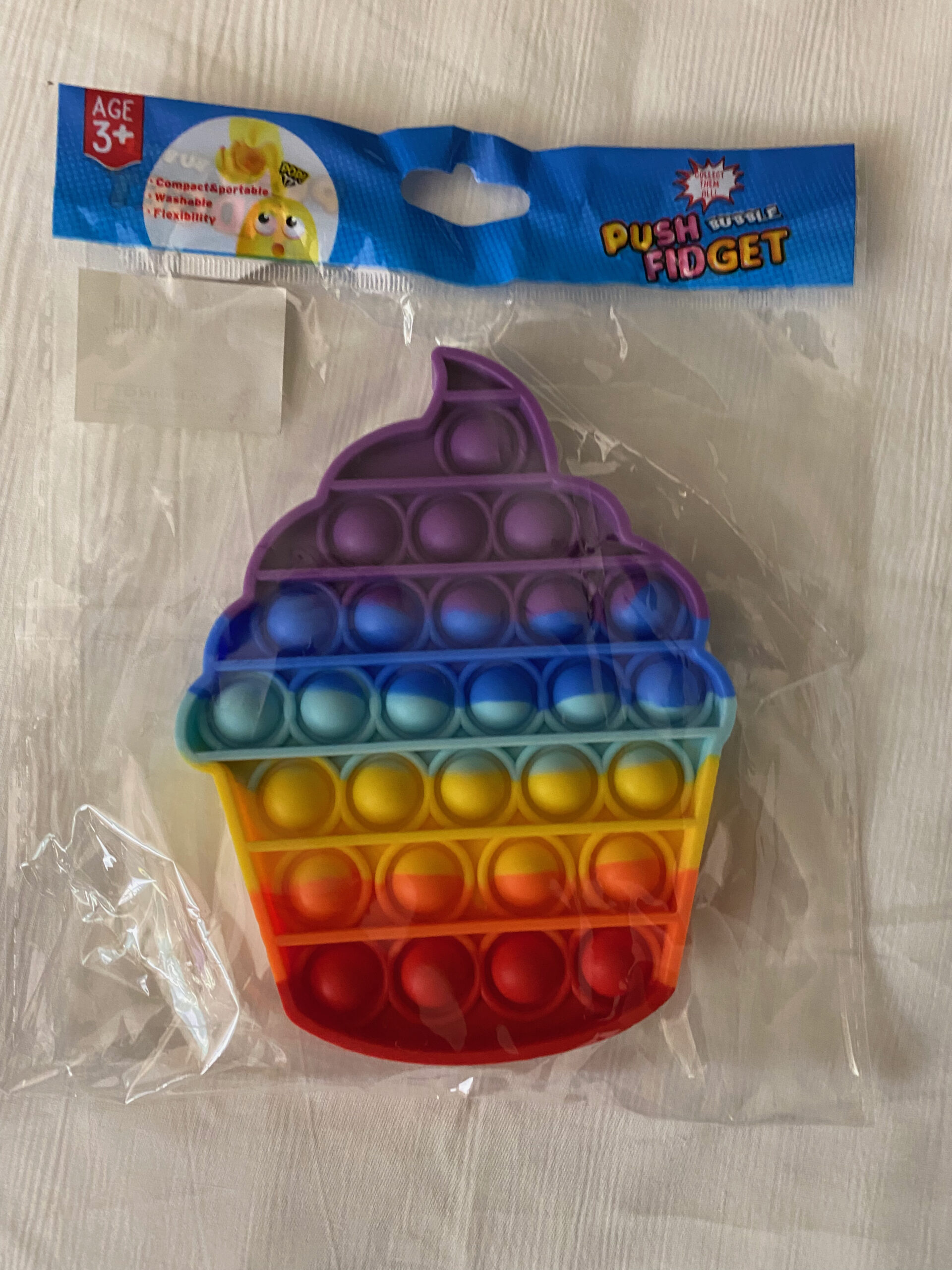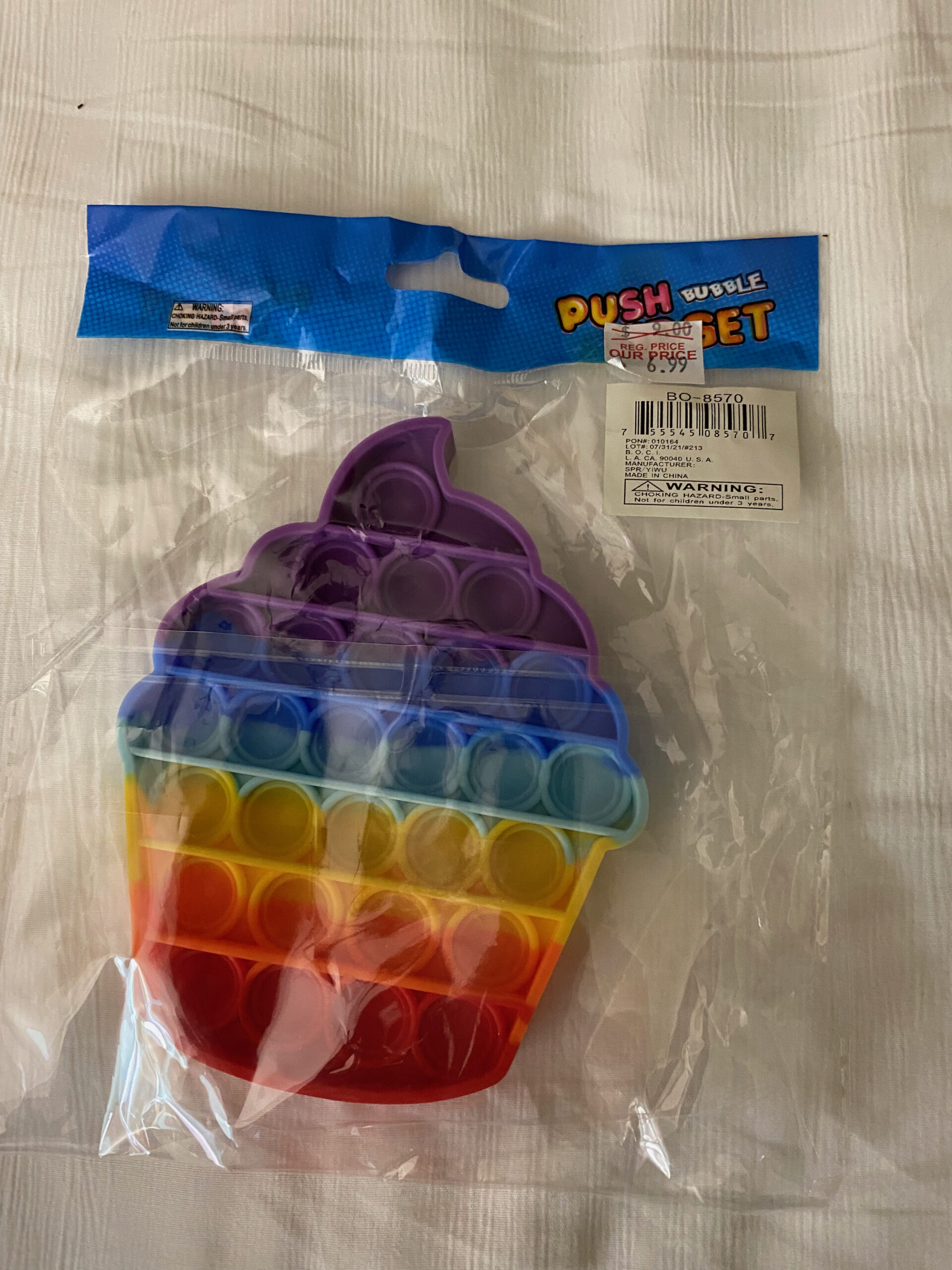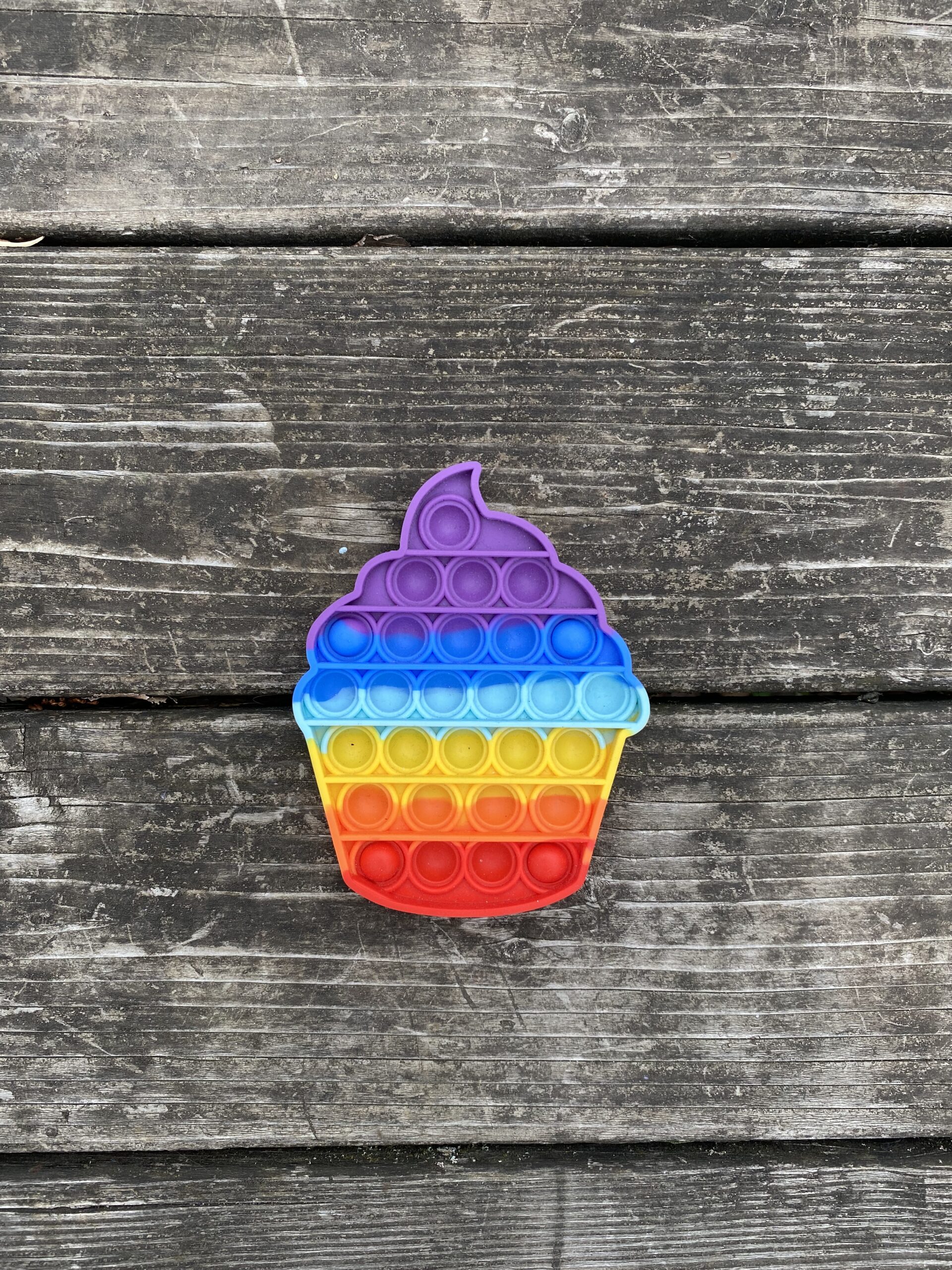Silicone Push Pop Bubble Fidget — Rainbow Frosted Cup Cake Design: 18 ppm Cadmium (a known carcinogen). Safe by all standards.
Introduction (for those new to this website):
Tamara Rubin is a federal-award-winning independent advocate for consumer goods safety and a documentary filmmaker. She is also a mother of Lead-poisoned children, her sons were acutely Lead-poisoned in 2005. Since 2009 Tamara has been using XRF testing (a scientific method used by the U.S. Consumer Product Safety Commission) to test consumer goods for toxicants (specifically heavy metals), including Lead, Cadmium, Mercury, Antimony, and Arsenic. All test results reported on this website are science-based, accurate, and replicable. Items are tested multiple times, to confirm the test results for each component. Tamara’s work was featured in Consumer Reports Magazine in February of 2023.

November 21, 2021 — Sunday
Folks have been asking me about these silicone “push pop bubble fidgets” pretty much non-stop for the past several months. I do this work (independent consumer goods testing for toxic heavy metals) so parents everywhere can make informed decisions for their own families. I want to be clear that I cannot make those decisions for another parent. Hopefully, the testing I do gives you some insight into making better choices for your family — educated choices.
If I did not do this testing, you would likely not have any way of knowing that these push pop bubble fidgets (whether name brand or off-brand) consistently test positive for trace levels of Cadmium. Now that you have this information, you could do any of the following:
- Choose to not be worried at all about these trace levels and continue to let your children play with them.
- Choose to do additional research on your own about the concern for Cadmium in consumer goods before deciding whether or not to keep these in your home.
- Choose to not let your children play with them based on this knowledge.
I can NOT tell you what to think or do
Decisions about items that have very low levels of one or more heavy metal toxicants ultimately boil down to an individual’s understanding/definition of, comfort level with, and philosophy/attitudes toward health and wellness, environmental consciousness or political beliefs, even religion, and/or other belief systems.
I can test, explain the results, and provide some context — but, in the end, you have to make these hard choices on your own for your family.
Information you might use to make your decisions on items like this:
As it relates to this specific toy (and other similar toys and household items made with silicone), here’s what I can share to help you make that decision (but I am not going to make the decision for you!):
Overarching consideration: pretty much all silicone (food grade/ medical grade, whatever) tests positive for trace levels of Cadmium. Check out the “Silicone with Trace Cadmium” category of posts here on the website for examples.
Specific Considerations
- By “trace” I mean “a very small amount” — an amount that is considered safe by all current standards (i.e. below the current levels of concern for this particular metal).
- In general (with some exceptions, like these cupcake cups), the levels of Cadmium found in silicone items are, in fact, considered “safe by all standards.”
- The various standards for Cadmium are discussed in this post — link.
- Cadmium is a known carcinogen (i.e. it causes cancer) and can build up in the body with persistent/chronic/repeated exposure.
- You have to decide if “safe levels” of a known carcinogen in a toy your child frequently interacts with is something you are comfortable with. Some of my readers will be comfortable with this, some will not be.
- My youngest son (currently 13 years old) no longer chews on things (and never really did), so I will let him continue to use toys like this — that are not at risk for ending up in his mouth. Under normal use as intended (not being chewed on), there is likely no risk presented by a toy like this considering that the Cadmium is likely bound in the silicone material (when the item is used as intended — a toy).
- HOWEVER… If you have a child who might chew on this sort of toy, you might want to re-think whether or not you let them play with these (and other similar silicone chew toys and necklaces). These toys in particular would be very attractive to a child with Pica — or any child who likes to chew on things. I don’t believe the possible migration of Cadmium from silicone toys, which might deteriorate over time in the presence of saliva (and in particular, toys that were not designed to be chewed), has been tested at all. This is the primary potential concern with these products. (I have tested very few silicone chew toys that have been 100% negative for Cadmium — here’s one example.)
Below are the full XRF test results for the toy pictured:
Reading #1) On Purple Area
60-second test
- Lead (Pb): non-detect
- Cadmium (Cd): 12 +/- 2 ppm
- Mercury (Hg): non-detect
- Bromine (Br): non-detect
- Chromium (Cr): non-detect
- Zinc (Zn): 193 +/- 10 ppm
- Nb: 518 +/- 9 ppm
- Indium (In): 13 +/- 3 ppm
- Tin (Sn): 11 +/- 3 ppm
- No other metals were detected in consumer goods mode.
Reading #2) On Blue Area (two-tone)
30-second test
- Lead (Pb): non-detect
- Cadmium (Cd): 16 +/- 3 ppm
- Mercury (Hg): non-detect
- Bromine (Br): non-detect
- Chromium (Cr): non-detect
- Zinc (Zn): 175 +/- 14 ppm
- Nb: 562 +/- 14 ppm
- Indium (In): 14 +/- 4 ppm
- Tin (Sn): 11 +/- 5 ppm
- No other metals were detected in consumer goods mode.
Reading #4) On Yellow Area
60-second test
- Lead (Pb): non-detect
- Cadmium (Cd): 15 +/- 2 ppm
- Mercury (Hg): non-detect
- Bromine (Br): non-detect
- Chromium (Cr): non-detect
- Zinc (Zn): 218 +/- 11 ppm
- Titanium (Ti): 790 +/- 408
- Nb: 585 +/- 10 ppm
- Indium (In): 17 +/- 3 ppm
- Tin (Sn): 10 +/- 3 ppm
- No other metals were detected in consumer goods mode.
Reading #5) On Orange Area
30-second test
- Lead (Pb): non-detect
- Cadmium (Cd): 13 +/- 3 ppm
- Mercury (Hg): non-detect
- Bromine (Br): non-detect
- Chromium (Cr): non-detect
- Zinc (Zn): 176 +/- 13 ppm
- Nb: 486 +/- 12 ppm
- Indium (In): 16 +/- 4 ppm
- Tin (Sn): 8 +/- 4 ppm
- No other metals were detected in consumer goods mode.
Reading #6) On red Area
60-second test
- Lead (Pb): non-detect
- Cadmium (Cd): 18 +/- 2 ppm
- Mercury (Hg): non-detect
- Bromine (Br): non-detect
- Chromium (Cr): non-detect
- Iron (Fe): 65 +/- 39 ppm
- Zinc (Zn): 211 +/- 11 ppm
- Nb: 639 +/- 11 ppm
- Indium (In): 17 +/- 3 ppm
- Tin (Sn): 12 +/- 3 ppm
- No other metals were detected in consumer goods mode.
Thank you for reading and sharing my posts. As always, please let me know if you have any questions and I will do my best to answer them personally as soon as I have a moment.
Tamara Rubin
#LeadSafeMama
Never Miss an Important Article Again!
Join our Email List











Have you tested silicone ice cube trays? I’ve been looking & can’t find anything!